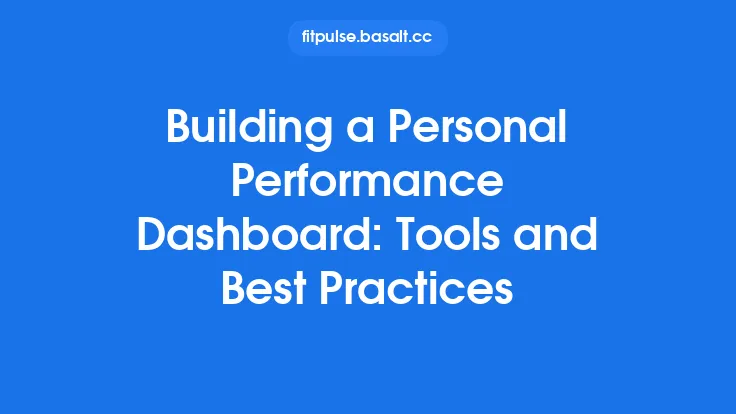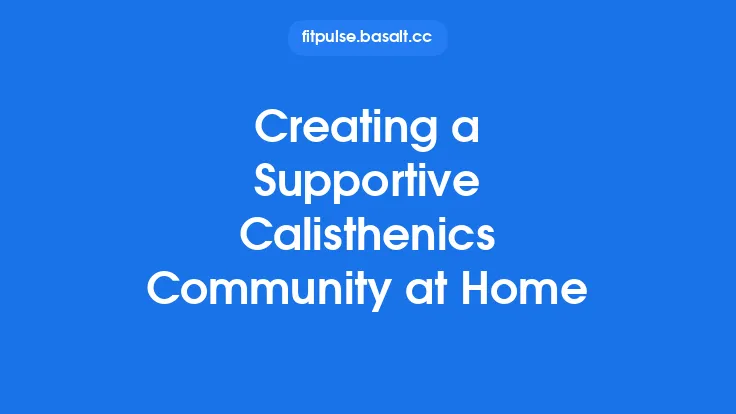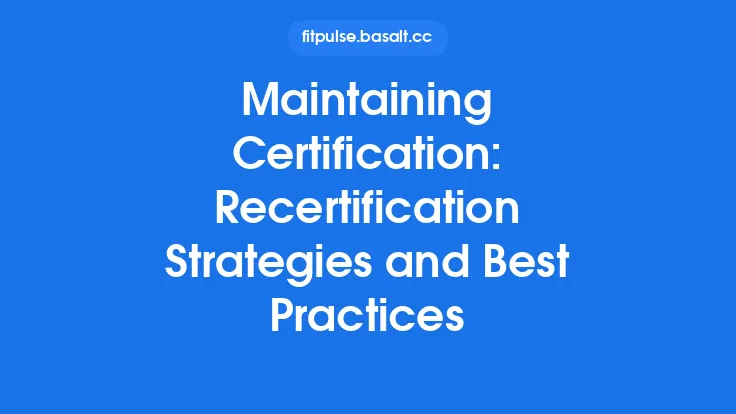Building a thriving online fitness community is more than just assembling a group of people who happen to share an interest in health. It requires intentional design, clear processes, and ongoing stewardship to ensure members feel welcomed, supported, and motivated to stay active together. Below are best‑practice guidelines that help creators of gamified fitness platforms and social‑tracking apps cultivate a vibrant, inclusive, and sustainable community.
Understanding the Core Elements of a Supportive Community
A supportive community rests on three interlocking pillars:
- Clear Purpose and Shared Values – Define what the community stands for (e.g., inclusive wellness, lifelong movement, balanced lifestyle) and communicate it consistently. A concise mission statement helps members self‑select and aligns expectations.
- Structured Interaction Framework – Provide predictable ways for members to engage (forums, group chats, activity feeds, live streams). Consistency reduces friction and encourages habitual participation.
- Feedback Loops – Establish mechanisms for members to voice concerns, suggest improvements, and celebrate achievements. Transparent response processes reinforce trust and demonstrate that the platform values its users.
When these pillars are deliberately built into the platform’s architecture, the community can evolve organically while staying anchored to its original intent.
Onboarding New Members Effectively
First impressions shape long‑term engagement. A smooth onboarding flow should include:
- Guided Tours – Interactive walkthroughs that highlight key features (activity feed, challenge creation, messaging) reduce the learning curve.
- Personalized Goal Setup – Prompt newcomers to set realistic, measurable goals (e.g., “Run 3 km three times a week”). Linking these goals to community groups (beginner runners, weekend walkers) immediately places them in a relevant social context.
- Welcome Packets – Automated messages that bundle community guidelines, a list of popular groups, and a “starter badge” for completing the onboarding steps. This early reward signals that participation is recognized from day one.
- Mentor Pairing – Assign a volunteer mentor or “community buddy” who can answer questions and model positive interaction. A brief introductory chat helps the new member feel seen and reduces the intimidation of a large user base.
Designing Inclusive Communication Channels
Inclusivity is a cornerstone of support. To make communication accessible to a diverse audience:
- Multiple Modalities – Offer text‑based forums, voice channels, and video rooms. Users can choose the format that best fits their comfort level and technical resources.
- Language Support – Implement translation tools or multilingual sub‑communities. Even simple auto‑translation of posts can prevent language barriers from isolating non‑English speakers.
- Accessibility Features – Ensure all UI elements meet WCAG 2.1 AA standards: high‑contrast text, scalable fonts, screen‑reader compatibility, and captioned video streams.
- Topic Tagging System – Allow members to tag posts with activity type, intensity level, or health focus (e.g., “low‑impact,” “post‑rehab”). Tag filters help users discover content that matches their abilities and interests.
Leveraging Gamified Mechanics to Strengthen Social Bonds
Gamification can reinforce community cohesion when applied thoughtfully:
- Group‑Based Badges – Instead of rewarding only individual milestones, create badges that require collective effort (e.g., “10 k km walked by the neighborhood group”). This encourages members to cheer each other on and coordinate activity.
- Co‑Op Challenges – Design challenges where the success metric is shared (total calories burned by a team, cumulative steps in a month). The platform should display real‑time progress bars for each group, fostering a sense of shared purpose.
- Recognition Boards – Highlight members who consistently support others (e.g., “Top Encourager of the Week”). Public acknowledgment of social contributions reinforces the value of helping behavior.
- Progressive Community Levels – As the community reaches certain thresholds (e.g., 5 000 active members), unlock new platform features for everyone—such as advanced analytics dashboards or exclusive live‑class sessions. This ties community growth to tangible benefits.
Implementing Peer Mentorship and Coaching Programs
Peer mentorship amplifies support without over‑relying on professional staff:
- Mentor Credentialing – Allow experienced members to apply for a “Mentor” badge after completing a short training module covering communication etiquette, basic injury‑prevention advice, and platform policies.
- Mentor‑Mentee Matching Algorithm – Use data points such as activity preferences, geographic proximity, and goal similarity to suggest pairings. The algorithm should prioritize balanced matches (e.g., a beginner runner paired with a seasoned runner who enjoys a similar pace).
- Scheduled Check‑Ins – Provide built‑in calendar tools for mentors and mentees to set recurring check‑ins (weekly or bi‑weekly). Automated reminders keep the relationship active.
- Feedback Collection – After each mentorship cycle, solicit ratings and comments to refine the matching process and recognize high‑performing mentors.
Moderation and Safety Protocols
A safe environment is essential for sustained participation:
- Community Guidelines – Draft concise, enforceable rules covering harassment, misinformation, and self‑harm content. Pin the guidelines in prominent locations and require new users to acknowledge them during sign‑up.
- Tiered Moderation Model – Combine automated filters (keyword detection, image scanning) with human moderators. Automated tools handle high‑volume noise, while trained moderators address nuanced disputes.
- Reporting Workflow – Enable one‑click reporting on posts, comments, or user profiles. The system should route reports to the appropriate moderation tier and provide status updates to the reporter.
- Escalation Pathways – For severe cases (e.g., threats of self‑injury), integrate with external crisis‑intervention services via API, ensuring rapid response while respecting user privacy.
- Transparency Reports – Publish periodic summaries of moderation actions (number of reports, types of violations, outcomes). Transparency builds trust and demonstrates accountability.
Data Integration and Seamless Tracking
While privacy considerations are outside the scope of this article, ensuring that activity data flows smoothly into the community experience is vital:
- Standardized API Endpoints – Adopt industry‑wide protocols (e.g., Open mHealth, Health Level Seven FHIR) to ingest data from wearables, smartphones, and third‑party apps. Consistent data structures simplify aggregation for group metrics.
- Real‑Time Sync – Implement WebSocket or server‑sent events to push live activity updates to the community feed, allowing members to see each other’s progress instantly.
- Normalization Engine – Convert disparate data formats (steps, distance, calories) into a unified “effort score” that can be used for group challenges without penalizing users whose devices report in different units.
- Offline Buffering – Store activity locally when connectivity is lost and sync automatically once the device reconnects, preventing gaps in community visibility.
Measuring Community Health and Success
Quantitative and qualitative metrics help gauge whether the community is truly supportive:
| Metric | Description | Why It Matters |
|---|---|---|
| Active Participation Rate | Percentage of members who post, comment, or react at least once per week. | Indicates ongoing engagement beyond passive tracking. |
| Retention Cohort | Track groups of users who joined in the same month and measure how many remain active after 3, 6, and 12 months. | Highlights long‑term community value. |
| Mentor‑Mentee Success Ratio | Ratio of mentorship pairs that report goal attainment or satisfaction. | Reflects effectiveness of peer support structures. |
| Sentiment Score | Natural language processing of forum posts to gauge overall positivity vs. negativity. | Early warning for emerging toxicity. |
| Challenge Completion Rate | Percentage of launched group challenges that reach their target. | Shows whether challenges are appropriately scoped and motivating. |
| Recognition Distribution | Analysis of how often badges and shout‑outs are awarded across member tiers. | Ensures recognition is not concentrated among a few power users. |
Regularly reviewing these indicators enables platform managers to adjust policies, introduce new features, or intervene when community health declines.
Scaling and Evolving the Community Over Time
As membership grows, the community architecture must adapt:
- Modular Feature Rollout – Deploy new tools (e.g., regional sub‑groups, advanced analytics) as separate modules that can be toggled on/off. This prevents disruption to existing workflows.
- Decentralized Leadership – Empower trusted members to become “community champions” who moderate specific sub‑groups or host live events. Provide them with admin dashboards that limit their scope to their domain, reducing the burden on central staff.
- Dynamic Content Curation – Use recommendation algorithms to surface relevant posts, challenges, and mentors based on a member’s activity history and expressed interests. Continual refinement of these models keeps the feed fresh and personalized.
- Feedback‑Driven Roadmap – Maintain an open suggestion board where members can vote on upcoming features. Prioritizing high‑impact community requests demonstrates that the platform evolves with its users.
- Infrastructure Scaling – Leverage cloud‑native services (auto‑scaling containers, managed databases) to handle spikes in activity during major events (e.g., global step‑count challenges) without latency or downtime.
Best Practices Checklist
- Define a clear mission and embed it in onboarding, UI copy, and community communications.
- Create a frictionless onboarding flow with guided tours, goal setup, and mentor pairing.
- Offer inclusive communication channels (text, voice, video) with robust accessibility support.
- Use group‑focused gamified elements (co‑op challenges, collective badges) to reinforce social ties.
- Implement a structured mentorship program with credentialing, matching algorithms, and feedback loops.
- Establish transparent moderation policies and a tiered response system for safety.
- Integrate activity data via standardized APIs and provide real‑time, normalized feeds.
- Track community health metrics (participation, retention, sentiment) and act on insights.
- Scale responsibly through modular features, decentralized leadership, and cloud‑native infrastructure.
- Iterate based on member feedback and celebrate community milestones publicly.
By adhering to these practices, creators of gamified fitness platforms can nurture online spaces where members feel genuinely supported, motivated to stay active together, and empowered to contribute to a collective journey toward healthier living.




